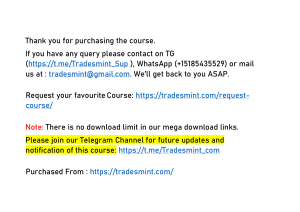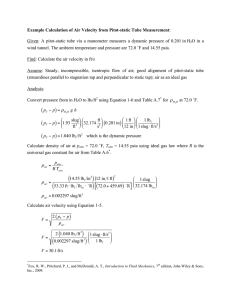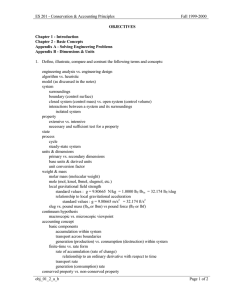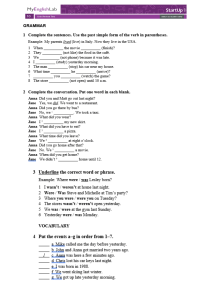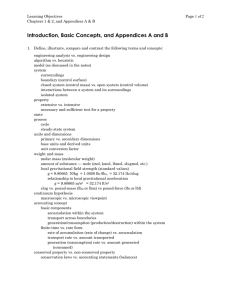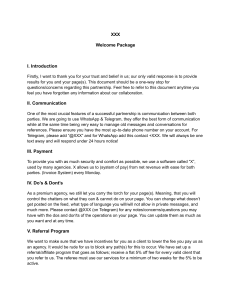Sample for Solution Manual Fox and McDonald's Introduction to Fluid Mechanics 10th Edition by John Mitchell
advertisement
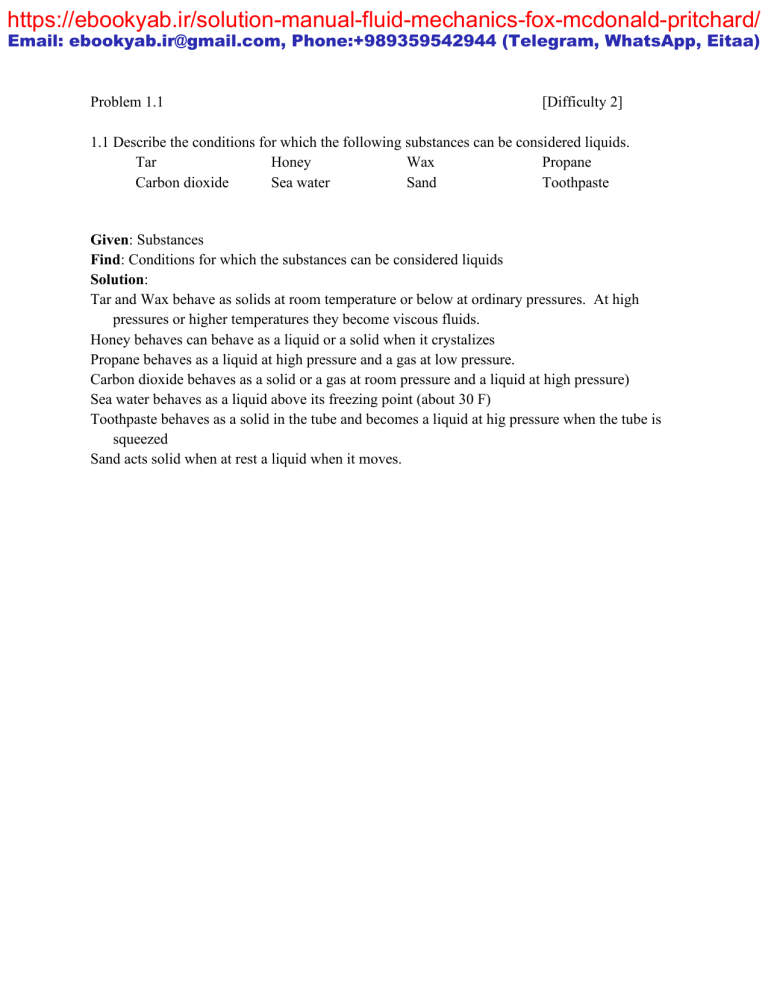
https://ebookyab.ir/solution-manual-fluid-mechanics-fox-mcdonald-pritchard/ Email: ebookyab.ir@gmail.com, Phone:+989359542944 (Telegram, WhatsApp, Eitaa) Problem 1.1 [Difficulty 2] 1.1 Describe the conditions for which the following substances can be considered liquids. Tar Honey Wax Propane Carbon dioxide Sea water Sand Toothpaste Given: Substances Find: Conditions for which the substances can be considered liquids Solution: Tar and Wax behave as solids at room temperature or below at ordinary pressures. At high pressures or higher temperatures they become viscous fluids. Honey behaves can behave as a liquid or a solid when it crystalizes Propane behaves as a liquid at high pressure and a gas at low pressure. Carbon dioxide behaves as a solid or a gas at room pressure and a liquid at high pressure) Sea water behaves as a liquid above its freezing point (about 30 F) Toothpaste behaves as a solid in the tube and becomes a liquid at hig pressure when the tube is squeezed Sand acts solid when at rest a liquid when it moves. https://ebookyab.ir/solution-manual-fluid-mechanics-fox-mcdonald-pritchard/ Email: ebookyab.ir@gmail.com, Phone:+989359542944 (Telegram, WhatsApp, Eitaa) Problem 1.2 Problem 1.2 [Difficulty: 2] 1.2 1.2 Given: Five basic conservation laws stated in Section 1-4. 1.2 Write: A word statement of each, as they apply to a system. Solution: Assume that laws are to be written for a system. a. Conservation of mass — The mass of a system is constant by definition. b. Newton's second law of motion — The net force acting on a system is directly proportional to the product of the system mass times its acceleration. c. First law of thermodynamics — The change in stored energy of a system equals the net energy added to the system as heat and work. d. Second law of thermodynamics — The entropy of any isolated system cannot decrease during any process between equilibrium states. e. Principle of angular momentum — The net torque acting on a system is equal to the rate of change of angular momentum of the system. https://ebookyab.ir/solution-manual-fluid-mechanics-fox-mcdonald-pritchard/ Email: ebookyab.ir@gmail.com, Phone:+989359542944 (Telegram, WhatsApp, Eitaa) Problem 1.3 Problem 1.3 [Difficulty: 3] 1.3 Open-Ended Problem Statement: The barrel of a bicycle tire pump becomes quite warm during use. Explain the mechanisms responsible for the temperature increase. Discussion: Two phenomena are responsible for the temperature increase: (1) friction between the pump piston and barrel and (2) temperature rise of the air as it is compressed in the pump barrel. Friction between the pump piston and barrel converts mechanical energy (force on the piston moving through a distance) into thermal energy as a result of friction. Lubricating the piston helps to provide a good seal with the pump barrel and reduces friction (and therefore force) between the piston and barrel. Temperature of the trapped air rises as it is compressed. The compression is not adiabatic because it occurs during a finite time interval. Heat is transferred from the warm compressed air in the pump barrel to the cooler surroundings. This raises the temperature of the barrel, making its outside surface warm (or even hot!) to the touch. https://ebookyab.ir/solution-manual-fluid-mechanics-fox-mcdonald-pritchard/ Email: ebookyab.ir@gmail.com, Phone:+989359542944 (Telegram, WhatsApp, Eitaa) Problem 1.12 1.4 Problem [Difficulty: 3] 1.4 Given: Data on sphere and terminal speed. Find: Drag constant k, and time to reach 99% of terminal speed. Solution: Use given data; integrate equation of motion by separating variables. kVt − 13 M = 1 × 10 The data provided are: mg ft Vt = 0.2⋅ s ⋅ slug M⋅ Newton's 2nd law for the general motion is (ignoring buoyancy effects) dV dt M ⋅ g = k ⋅ Vt Newton's 2nd law for the steady state motion becomes (ignoring buoyancy effects) − 13 k = 1 × 10 ⋅ slug × 32.2⋅ ft 2 2 s × 0.2⋅ ft s × = M⋅ g − k⋅ V k = 1.61 × 10 slug⋅ ft ⋅ M k − 13 ⋅ slug × M⋅ g − 11 ⋅ lbf ⋅ s × Vt lbf ⋅ s slug⋅ ft g− = dt k M ⋅V ⋅ V⎞ ⎠ V = 0.198 ⋅ 2 ft 1.61 × 10 t = 0.0286 s ⎝ k V = 0.99⋅ Vt We must evaluate this when t = −1 × 10 ⋅ ln⎛⎜ 1 − M⋅ g ft dV t=− k = so − 11 lbf ⋅ s lbf ⋅ s To find the time to reach 99% of Vt, we need V(t). From 1, separating variables Integrating and using limits (1) ⎛ ⋅ ln⎜ 1 − 1.61 × 10 ⎜ ⎝ ft s − 11 lbf ⋅ s ⋅ ft × 2 1 − 13 1 × 10 ⋅ slug × s 32.2⋅ ft × 0.198 ⋅ ft s × slug⋅ ft ⎞ 2 lbf ⋅ s ⎠ https://ebookyab.ir/solution-manual-fluid-mechanics-fox-mcdonald-pritchard/ Email: ebookyab.ir@gmail.com, Phone:+989359542944 (Telegram, WhatsApp, Eitaa) Problem 1.5 [Difficulty 2] 1.5 A rocket payload with a weight on earth of 2000 lbf is sent to the moon. The acceleration due to gravity in the moon is 1/6th that of the earth. Determine the mass of the payload on the earth and on the moon and the weight of the payload on the moon in SI, BG, EE units. The weight in EE units is the same as in BG units, or Wm = 333 lbf In SI units, the conversion of the weight from lbf to Newtons yields the weight as 4.444 N Wm =333 lbf ⋅ =1480 N lbf https://ebookyab.ir/solution-manual-fluid-mechanics-fox-mcdonald-pritchard/ Email: ebookyab.ir@gmail.com, Phone:+989359542944 (Telegram, WhatsApp, Eitaa) Problem 1.6 Problem 1.16 [Difficulty: 3] 1.6 Given: Long bow at range, R = 100 m. Maximum height of arrow is h = 10 m. Neglect air resistance. Find: Estimate of (a) speed, and (b) angle, of arrow leaving the bow. Plot: (a) release speed, and (b) angle, as a function of h Solution: Let V0 = u 0 i + v 0 j = V0 (cos θ 0 i + sin θ 0 j) y ΣFy = m dv = − mg , so v = v0 – gt, and tf = 2tv=0 = 2v0/g dt v2 dv = − mg, v dv = −g dy, 0 − 0 = − gh dy 2 Also, mv Thus h = v 20 2g ΣFx = m v 20 = 2gh From Eq. 2: u0 = x θ0 R (1) 2u v du = 0, so u = u 0 = const, and R = u 0 t f = 0 0 dt g From Eq. 1: h V0 (2) (3) gR gR = 2v 0 2 2gh ∴ u 20 = gR 2 8h 1 Then ⎛ gR 2 gR 2 ⎞ 2 ⎟ + 2 gh and V0 = ⎜⎜ 2 gh + V =u +v = 8h 8h ⎟⎠ ⎝ 2 0 2 0 2 0 (4) 1 ⎛ m 9.81 m 1 ⎞2 m ⎟⎟ = 37.7 V0 = ⎜⎜ 2 × 9.81 2 × 10 m + × 100 2 m 2 × 2 s 8 s 10 m s ⎝ ⎠ From Eq. 3: v 0 = 2gh = V0 sin θ , θ = sin −1 2gh V0 (5) https://ebookyab.ir/solution-manual-fluid-mechanics-fox-mcdonald-pritchard/ Email: ebookyab.ir@gmail.com, Phone:+989359542944 (Telegram, WhatsApp, Eitaa) 1 ⎡ ⎤ 2 m s ⎥ ⎛ ⎞ θ = sin ⎢⎜ 2 × 9.81 2 ×10 m ⎟ × = 21.8° ⎢⎝ s ⎠ 37.7 m ⎥ ⎣ ⎦ −1 Plots of V0 = V0(h) (Eq. 4) and θ0 = θ 0(h) (Eq. 5) are presented below: V 0 (m/s) Initial Speed vs Maximum Height 80 70 60 50 40 30 20 10 0 0 5 10 15 20 25 30 25 30 h (m) Initial Angle vs Maximum Height 60 50 o θ ( ) 40 30 20 10 0 0 5 10 15 h (m) 20 https://ebookyab.ir/solution-manual-fluid-mechanics-fox-mcdonald-pritchard/ Email: ebookyab.ir@gmail.com, Phone:+989359542944 (Telegram, WhatsApp, Eitaa) Problem 1.7 [Difficulty 2] 1.7 Air at standard atmospheric conditions enters the 6 in. diameter inlet of an air compressor at a velocity of 20 ft/s. The air is compressed and leaves the compressor through a 6 in. diameter outlet at 80 psia and 150 oF. Determine the mass flow rate of the air and the exit velocity. Given Air at standard atmospheric conditions, V = 20 ft/s. Find Mass flow rate of air and exit velocity Solution: The mass flow rate is given by the continuity equation m = ρ AV The density at standard conditions is taken from Table A.9 as ρ = 0.00238 The flow area is slug ft 3 2 ( 0.5 ft ) = D2 = π π⋅ A= 0.1963 ft 2 4 4 The mass flow rate is then slug ft slug m = ρ AV = 0.00238 3 ⋅ 0.1963 ft 2 ⋅ 20 = 0.00935 s s ft To determine the velocity at the exit, we need the density of air at 80 psia and 150 F. The ideal gas equation of state (Eq. 1.1) is used lbf 144in 80 2 ⋅ p slug slug in ft 2 0.01101 3 ρ == ⋅ = RT 53.33 ft ⋅ lbf ⋅ 150 + 459.6 R 32.2 lbm ft ( ) lbm ⋅ R The exit velocity is then found using the continuity equation, where the outlet area equals the inlet area slug 0.00935 m ft s = = 4.32 V = ρ A 0.01101 slug ⋅ 0.1963 ft 2 s 3 ft https://ebookyab.ir/solution-manual-fluid-mechanics-fox-mcdonald-pritchard/ Email: ebookyab.ir@gmail.com, Phone:+989359542944 (Telegram, WhatsApp, Eitaa) Problem 1.8 [Difficulty 2] 1.8 A water flow of 4.50 slug/s at 60 oF enters the condenser of steam turbine and leaves at 140 o F. Determine the heat transfer rate (Btu/hr) and the entropy change per slug of water. Given: Condenser with water flow of 4500 slug/s entering at 60 oF, leaving at 140 oF. Find: Heat transfer rate and entropy change of water Solution: The heat transfer is determined using the energy equation = Q m ( ho − hi ) For water, the enthalpy difference for a constant pressure process is ( ho − hi )= c (To − Ti ) The heat transfer is then (To − Ti )= 4.50 Q= m ( ho − hi )= mc = 41.8 x106 Btu hr slug Btu lbm s ⋅1.00 ⋅ 3600 (140 − 60 ) F ⋅ 32.2 s lbm ⋅ F slug hr https://ebookyab.ir/solution-manual-fluid-mechanics-fox-mcdonald-pritchard/ Email: ebookyab.ir@gmail.com, Phone:+989359542944 (Telegram, WhatsApp, Eitaa) Problem 1.9 (Difficulty: 1) 1.9 Determine the weight (N) and specific volume of a cubic meter of air at 101 kPa and 15 ℃. Determine the specific volume if the air is cooled to −10 ℃ at constant pressure. Given: Specific weight 𝛾𝛾 = 12.0 𝑁𝑁 𝑚𝑚3 at 101 𝑘𝑘𝑘𝑘𝑘𝑘 and 15 ℃. Find: The specific volume 𝑣𝑣 at 101 𝑘𝑘𝑘𝑘𝑘𝑘 and 15 ℃. Also the specific volume 𝑣𝑣 at 101 𝑘𝑘𝑘𝑘𝑘𝑘 and −10 ℃. Assume: Air can be treated as an ideal gas Solution: Basic equation: ideal gas law: 𝑝𝑝𝑝𝑝 = 𝑅𝑅𝑅𝑅 The specific volume is equal to the reciprocal of the specific weight divided by gravity 𝑣𝑣1 = 𝑔𝑔 𝛾𝛾 Using the value of gravity in the SI units, the specific volume is The temperature conditions are 𝑚𝑚 𝑔𝑔 9.81 𝑠𝑠 2 𝑚𝑚3 = 0.818 𝑣𝑣1 = = 12.0 𝑁𝑁 𝑘𝑘𝑘𝑘 𝛾𝛾 𝑇𝑇1 = 15 ℃ = 288 𝐾𝐾, 𝑇𝑇2 = −10 ℃ = 263𝐾𝐾 For 𝑣𝑣2 at the same pressure of 101 𝑘𝑘𝑘𝑘𝑘𝑘 and cooled to −10 ℃ we have, because the gas constant is the same at both pressures: 𝑅𝑅𝑇𝑇1 𝑣𝑣1 𝑇𝑇1 𝑝𝑝 = = 𝑣𝑣2 𝑅𝑅𝑇𝑇2 𝑇𝑇2 𝑝𝑝 So the specific volume is 𝑣𝑣2 = 𝑣𝑣1 𝑚𝑚3 263 𝐾𝐾 𝑚𝑚3 𝑇𝑇2 = 0.818 × = 0.747 𝑇𝑇1 𝑘𝑘𝑘𝑘 288 𝐾𝐾 𝑘𝑘𝑘𝑘 https://ebookyab.ir/solution-manual-fluid-mechanics-fox-mcdonald-pritchard/ Email: ebookyab.ir@gmail.com, Phone:+989359542944 (Telegram, WhatsApp, Eitaa) Problem 1.10 (Difficulty: 2) 1.10 Determine the specific weight, specific volume, and density of air at 40℉ and 50 psia in BG units. Determine the specific weight, specific volume, and density when the air is then compressed isentropically to 100 psia. Determine the specific weight, specific volume, and density of air at 40℉ and 50 psia in BG units. Determine the specific weight, specific volume, and density when the air is then compressed isentropically to 100 psia. Given: Air temperature: 40℉, Air pressure 50 psia. Find: The specific weight, specific volume and density at 40℉ and 50 psia and the values at 100 psia after isentropic compression. Assume: Air can be treated as an ideal gas Solution: Basic equation: 𝑝𝑝𝑝𝑝 = 𝑅𝑅𝑅𝑅 The absolute temperature is The gas constant is The specific volume is: 𝑇𝑇1 = 40℉ = 500°𝑅𝑅 𝑅𝑅 = 1715 𝑓𝑓𝑓𝑓 ∙ 𝑙𝑙𝑙𝑙𝑙𝑙 𝑠𝑠𝑠𝑠𝑠𝑠𝑠𝑠 ∙ °𝑅𝑅 𝑓𝑓𝑓𝑓 ∙ 𝑙𝑙𝑙𝑙𝑙𝑙 1715 𝑅𝑅𝑇𝑇1 𝑓𝑓𝑓𝑓 3 𝑠𝑠𝑠𝑠𝑠𝑠𝑠𝑠 ∙ °𝑅𝑅 𝑣𝑣1 = = × 500°𝑅𝑅 = 119.1 144𝑖𝑖𝑖𝑖2 𝑝𝑝 𝑠𝑠𝑠𝑠𝑠𝑠𝑠𝑠 50𝑝𝑝𝑝𝑝𝑝𝑝𝑝𝑝 × 𝑓𝑓𝑓𝑓 2 The density is the reciprocal of the specific volume 𝜌𝜌1 = 1 𝑠𝑠𝑠𝑠𝑠𝑠𝑠𝑠 = 0.0084 𝑣𝑣1 𝑓𝑓𝑓𝑓 3 Using Newton’s second law, the specific weight is the density times gravity: 𝛾𝛾1 = 𝜌𝜌𝜌𝜌 = 0.271 𝑙𝑙𝑙𝑙𝑙𝑙 𝑓𝑓𝑓𝑓 3 https://ebookyab.ir/solution-manual-fluid-mechanics-fox-mcdonald-pritchard/ Email: ebookyab.ir@gmail.com, Phone:+989359542944 (Telegram, WhatsApp, Eitaa) For the isentropic compression of air to 100 psia, we have the relation for entropy change of an ideal gas: 𝑇𝑇 𝑝𝑝 𝑠𝑠2 − 𝑠𝑠1 = 𝑐𝑐𝑝𝑝 ln 𝑇𝑇2 − 𝑅𝑅 ln 𝑝𝑝2 1 The definition of an isentropic process is 𝑠𝑠2 = 𝑠𝑠1 Solving for the temperature ratio The values of R and specific heat are 𝑅𝑅 = 1715 1 𝑇𝑇2 𝑝𝑝2 𝑅𝑅/𝑐𝑐𝑝𝑝 =� � 𝑇𝑇1 𝑝𝑝1 𝑓𝑓𝑓𝑓 ∙ 𝑙𝑙𝑙𝑙𝑙𝑙 𝑓𝑓𝑓𝑓 ∙ 𝑙𝑙𝑙𝑙𝑙𝑙 𝐵𝐵𝐵𝐵𝐵𝐵 = 53.3 = 0.0686 𝑠𝑠𝑠𝑠𝑠𝑠𝑠𝑠 ∙ °𝑅𝑅 𝑙𝑙𝑙𝑙 ∙ °𝑅𝑅 𝑙𝑙𝑙𝑙 ∙ °𝑅𝑅 𝑐𝑐𝑝𝑝 = 0.24 The temperature after compression to 100 psia is 𝐵𝐵𝐵𝐵𝐵𝐵 𝑙𝑙𝑙𝑙𝑙𝑙 𝑅𝑅 𝑝𝑝2 𝑅𝑅/𝑐𝑐𝑝𝑝 100 𝑝𝑝𝑝𝑝𝑝𝑝𝑝𝑝 0.0686/0.24 𝑇𝑇2 = 𝑇𝑇1 � � = 500 𝑅𝑅 � � = 610 °𝑅𝑅 𝑝𝑝1 50 𝑝𝑝𝑝𝑝𝑝𝑝𝑝𝑝 𝑝𝑝2 = 100 𝑝𝑝𝑝𝑝𝑝𝑝𝑝𝑝 = 14400 The specific volume is computed using the ideal gas law: 𝑙𝑙𝑙𝑙𝑙𝑙 𝑓𝑓𝑓𝑓 2 𝑓𝑓𝑓𝑓 ∙ 𝑙𝑙𝑙𝑙𝑙𝑙 1715 𝑅𝑅𝑇𝑇2 𝑓𝑓𝑓𝑓 3 𝑠𝑠𝑠𝑠𝑠𝑠𝑠𝑠 ∙ °𝑅𝑅 𝑣𝑣2 = = × 610.00°𝑅𝑅 = 72.6 144𝑖𝑖𝑖𝑖2 𝑝𝑝2 𝑠𝑠𝑠𝑠𝑠𝑠𝑠𝑠 100𝑝𝑝𝑠𝑠𝑠𝑠𝑠𝑠 × 𝑓𝑓𝑓𝑓 2 The density is the reciprocal of the specific volume The specific weight is: 𝜌𝜌2 = 1 𝑠𝑠𝑠𝑠𝑠𝑠𝑠𝑠 = 0.0138 𝑣𝑣2 𝑓𝑓𝑓𝑓 3 𝛾𝛾2 = 𝜌𝜌2 𝑔𝑔 = 0.444 𝑙𝑙𝑙𝑙𝑙𝑙 𝑓𝑓𝑓𝑓 3 https://ebookyab.ir/solution-manual-fluid-mechanics-fox-mcdonald-pritchard/ Email: ebookyab.ir@gmail.com, Phone:+989359542944 (Telegram, WhatsApp, Eitaa) Problem 1.17 Problem 1.11 [Difficulty: 2] 1.11 Given: Basic dimensions M, L, t and T. Find: Dimensional representation of quantities below, and typical units in SI and English systems. Solution: (a) Power Power = Energy Time Force × Distance = Time F⋅ L = t Force = Mass × Acceleration From Newton's 2nd law F= so M⋅ L t Power = Hence (b) Pressure (c) Modulus of elasticity (d) Angular velocity (e) Energy Pressure = Pressure = Force Area Force Area F⋅ L t F = L F = AngularVelocity = 2 L 2 M ⋅ L⋅ L = = 2 M⋅ L t ⋅t M⋅ L = 2 t ⋅L 2 M⋅ L = 2 t ⋅L Radians = Time 2 t 2 kg⋅ m 3 L⋅ t 3 L⋅ t (h) Shear stress (i) Strain (j) Angular momentum Strain = Area LengthChange Length F L 2 = = kg slug 2 1 1 1 t s s Momentum = Mass × Velocity = M ⋅ = ft⋅ s 2 M ⋅ L⋅ L M⋅ L = 2 t MomentOfForce = Force × Length = F⋅ L = Force 2 m⋅ s ft⋅ s Energy = Force × Distance = F⋅ L = ShearStress = slug m⋅ s M⋅ L 2 t ⋅L 2 L t = = 2 2 kg⋅ m 2 M ⋅ L⋅ L t (g) Momentum 3 2 2 2 slug⋅ ft 2 M⋅ L t 2 s 2 kg⋅ m 2 slug⋅ ft 2 s M⋅ L kg⋅ m slug⋅ ft t s s kg slug L⋅ t 2 2 2 m⋅ s L 2 2 s M 2 2 s = 2 s kg 2 M = slug⋅ ft s M = t (f) Moment of a force 2 2 ft⋅ s Dimensionless L AngularMomentum = Momentum × Distance = M⋅ L t ⋅L = M⋅ L t 2 2 kg⋅ m slugs⋅ ft s s 2 https://ebookyab.ir/solution-manual-fluid-mechanics-fox-mcdonald-pritchard/ Email: ebookyab.ir@gmail.com, Phone:+989359542944 (Telegram, WhatsApp, Eitaa) Problem 1.12 Problem 1.18 [Difficulty: 2] 1.12 Given: Basic dimensions F, L, t and T. Find: Dimensional representation of quantities below, and typical units in SI and English systems. Solution: (a) Power (b) Pressure (c) Modulus of elasticity (d) Angular velocity Power = Energy Pressure = Pressure = Time Force Area Force Area Force × Distance = Time L L s N lbf Radians Time = Force Area = ft N lbf ft 1 1 1 t s s N⋅ m lbf ⋅ ft or M= L t L t F = M⋅ = F⋅ t ⋅ L L⋅ t L t 2 = F⋅ t F L 2 m Force = Mass × Acceleration so Momentum = M ⋅ 2 m 2 From Newton's 2nd law SpecificHeat = s 2 Momentum = Mass × Velocity = M ⋅ (h) Specific heat t F = (f) Momentum ShearStress = lbf ⋅ ft 2 Energy = Force × Distance = F⋅ L (g) Shear stress N⋅ m 2 (e) Energy Hence F⋅ L F = AngularVelocity = = 2 2 N⋅ s lbf ⋅ s N lbf 2 m Energy Mass × Temperature = F⋅ L M⋅ T = F⋅ L L 2 2 ft F⋅ t L 2 2 m ft s ⋅K 2 s ⋅R 1 1 1 T K R N⋅ m⋅ s lbf ⋅ ft⋅ s ⎛ F⋅ t2 ⎞ ⎜ ⋅T ⎝ L ⎠ = 2 t ⋅T 2 LengthChange (i) Thermal expansion coefficient ThermalExpansionCoefficient = (j) Angular momentum Length Temperature = AngularMomentum = Momentum × Distance = F⋅ t⋅ L 2 https://ebookyab.ir/solution-manual-fluid-mechanics-fox-mcdonald-pritchard/ Email: ebookyab.ir@gmail.com, Phone:+989359542944 (Telegram, WhatsApp, Eitaa) Problem 1.13 [Difficulty 2] 1.13 The maximum theoretical flow rate (slug/s) for air flow through a supersonic nozzle is Ap given as m = 2.38 t 0 , where At is the nozzle throat area (ft2), p0 is the supply tank pressure T0 (psia), and T0 is the air temperature in the tank (oR). Determine the dimensions and units of the constant 2.38. Determine the equivalent equation in SI units. https://ebookyab.ir/solution-manual-fluid-mechanics-fox-mcdonald-pritchard/ Email: ebookyab.ir@gmail.com, Phone:+989359542944 (Telegram, WhatsApp, Eitaa) Problem 1.14 [Difficulty 1] 1.14 The mean free path λ of a molecule of gas is the average distance it travels before collision with another molecule. It is given by m λ =C ρ d2 where m and d are the molecule’s mass and diameter, respectively, and ρ is the gas density. Determine the dimensions of constant C for a dimensionally consistent equation. https://ebookyab.ir/solution-manual-fluid-mechanics-fox-mcdonald-pritchard/ Email: ebookyab.ir@gmail.com, Phone:+989359542944 (Telegram, WhatsApp, Eitaa) Problem 1.15 (Difficulty: 1) 1.15 The density of a sample of sea water is 1.99 slug/ft3. Determine the value of density in SI and EE units, and the value of specific weight in SI, BG and EE units Given: The density of sea water is 1.99 𝑠𝑠𝑠𝑠𝑠𝑠𝑠𝑠𝑠𝑠⁄𝑓𝑓𝑓𝑓 3 Find: The density of sea water in SI and EE units the value of specific weight in SI, BG and EE units. Solution: For the density in SI units: The relations between the units are 1 𝑚𝑚 = 3.28 𝑓𝑓𝑓𝑓 , 1 𝑘𝑘𝑘𝑘 = 0.0685 𝑠𝑠𝑠𝑠𝑠𝑠𝑠𝑠 For the density in EE units: 1 𝑠𝑠𝑠𝑠𝑠𝑠𝑠𝑠 1.99 × 0.0685 𝑘𝑘𝑘𝑘 𝑘𝑘𝑘𝑘 𝜌𝜌 = 1.99 3 = = 1026 3 1 𝑓𝑓𝑓𝑓 𝑚𝑚 𝑚𝑚3 3.283 The relation between a lbm and a slug is 1 𝑙𝑙𝑙𝑙𝑙𝑙 = 0.0311 𝑠𝑠𝑠𝑠𝑠𝑠𝑠𝑠 1 𝑠𝑠𝑠𝑠𝑠𝑠𝑠𝑠 1.99 × 0.0311 𝑙𝑙𝑙𝑙𝑙𝑙 𝑙𝑙𝑙𝑙𝑙𝑙 𝜌𝜌 = 1.99 3 = = 64.0 𝑓𝑓𝑓𝑓 3 𝑓𝑓𝑓𝑓 𝑓𝑓𝑓𝑓 3 For the specific weight in SI units, we use the relation between mass and weigh from Newton’s law W V mg V γ == == ρ g 1026 kg m 3 ⋅ 9.81 m s 2 = 10065 N m3 For the specific weight in EE and BG units, we use the relation between mass and weigh from Newton’s law W V mg Vgc g gc lbm 32.2 ft / s 2 lbf 64.0 3 = 32.2 ft ⋅ lbm / lbf s ft 64.0 3 ⋅ γ= = = ρ = ft 2 https://ebookyab.ir/solution-manual-fluid-mechanics-fox-mcdonald-pritchard/ Email: ebookyab.ir@gmail.com, Phone:+989359542944 (Telegram, WhatsApp, Eitaa) Problem 1.16 (Difficulty: 1) 1.16 A fluid occupying 3.2 𝑚3 has a mass of 4𝑀𝑀. Calculate its density and specific volume in SI, EE and BG units. Given: The fluid volume 𝑉 = 3.2 𝑚3 and mass 𝑚 = 4𝑀𝑀. Find: Density and specific volume in SI, EE and BG units. Solution: For SI units: The density is the mass divided by the volume 𝜌= 𝑚 4000 𝑘𝑘 𝑘𝑘 = = 1250 3 3 𝑉 3.2 𝑚 𝑚 The specific volume is the reciprocal of the density: For EE units: 𝑣= The density is: 1 𝜌= And the specific volume is: 𝑣= 𝑚3 1 = 8 × 10−4 𝜌 𝑘𝑘 𝑙𝑙𝑙 𝑘𝑘 = 16.0 𝑓𝑓 3 𝑚3 1250 𝑙𝑙𝑙 𝑙𝑙𝑙 = 78.0 16.0 𝑓𝑓 3 𝑓𝑓 3 1 𝑓𝑓 3 𝑓𝑓 3 1 = = 0.0128 𝜌 78.0 𝑙𝑙𝑙 𝑙𝑙𝑙 For BG unit, the relation between slug and lbm is: The density is: 1 𝜌= 𝑠𝑠𝑠𝑠 𝑙𝑙𝑙 = 32.2 3 𝑓𝑓 𝑓𝑓 3 78.0 𝑠𝑠𝑠𝑠 𝑠𝑠𝑠𝑠 = 2.43 3 32.2 𝑓𝑓 𝑓𝑓 3 https://ebookyab.ir/solution-manual-fluid-mechanics-fox-mcdonald-pritchard/ Email: ebookyab.ir@gmail.com, Phone:+989359542944 (Telegram, WhatsApp, Eitaa) And the specific volume is 𝑣= 1 𝑓𝑓 3 𝑓𝑓 3 1 = = 0.412 𝜌 2.43 𝑠𝑠𝑠𝑠 𝑠𝑠𝑠𝑠 https://ebookyab.ir/solution-manual-fluid-mechanics-fox-mcdonald-pritchard/ Email: ebookyab.ir@gmail.com, Phone:+989359542944 (Telegram, WhatsApp, Eitaa) Problem 1.17 Problem 1.20 [Difficulty: 1] 1.17 Given: Pressure, volume and density data in certain units Find: Convert to different units Solution: Using data from tables (e.g. Table G.2) 6895⋅ Pa 1⋅ psi = 1⋅ psi × (b) 1⋅ liter = 1⋅ liter × (c) ⎛ 1 ⋅ ft ⎞ lbf ⋅ s lbf ⋅ s 4.448⋅ N ⎜ 12 N⋅s 1⋅ = 1⋅ × ×⎜ = 47.9⋅ ⋅ ⎠ 2 2 2 1⋅ lbf ⎝ 0.0254m ft ft m 1⋅ psi × 1⋅ kPa (a) 1⋅ quart 0.946⋅ liter 1000⋅ Pa × = 6.89⋅ kPa 1⋅ gal 4⋅ quart = 0.264⋅ gal 2 https://ebookyab.ir/solution-manual-fluid-mechanics-fox-mcdonald-pritchard/ Email: ebookyab.ir@gmail.com, Phone:+989359542944 (Telegram, WhatsApp, Eitaa) Problem 1.23 1.18 Problem [Difficulty: 1] 1.18 Given: Quantities in English Engineering (or customary) units. Find: Quantities in SI units. Solution: Use Table G.2 and other sources (e.g., Google) (a) 100 ⋅ ft 3 m = 100 ⋅ ft 3 3 min 3 (b) 5 ⋅ gal = 5 ⋅ gal × (c) 65⋅ mph = 65⋅ 231 ⋅ in 1 ⋅ gal mile hr × 3 × ⎛ 0.0254⋅ m ⎞ = 0.0189⋅ m3 ⎜ ⎝ 1⋅ in ⎠ 1852⋅ m 1 ⋅ mile × 3 (d) 5.4⋅ acres = 5.4⋅ acre × 3 ⎛ 0.0254⋅ m × 12⋅ in ⎞ × 1 ⋅ min = 0.0472⋅ m ⎜ s 60⋅ s 1 ⋅ ft ⎠ ⎝ 1 ⋅ in × 4047⋅ m 1 ⋅ acre 1 ⋅ hr 3600⋅ s m = 29.1⋅ 4 s 2 = 2.19 × 10 ⋅ m https://ebookyab.ir/solution-manual-fluid-mechanics-fox-mcdonald-pritchard/ Email: ebookyab.ir@gmail.com, Phone:+989359542944 (Telegram, WhatsApp, Eitaa) Problem 1.19 Problem 1.24 1.19 Given: Quantities in SI (or other) units. Find: Quantities in BG units. Solution: Use Table G.2. Table appropriate (a) 50⋅ m = 50⋅ m × (b) 250⋅ cc = 250⋅ cm × (c) 100⋅ kW = 100⋅ kW × (d) 5⋅ 2 2 ⎛ 1⋅ in × 1⋅ ft ⎞ = 538⋅ ft 2 ⎜ ⋅ 12⋅ in ⎠ ⎝ 0.0254m 2 3 kg 2 m = 5⋅ kg 2 m × 3 ⎛ 1⋅ m × 1⋅ in × 1⋅ ft ⎞ = 8.83 × 10− 3⋅ ft 3 ⎜ 12⋅ in ⎠ ⋅ ⎝ 100⋅ cm 0.0254m 1000⋅ W 1⋅ kW × 1⋅ hp 746⋅ W = 134⋅ hp 2 ⋅ 1⋅ slug slug 12⋅ in ⎞ ⎛ 0.0254m × × = 0.0318⋅ ⎜ 2 14.95⋅ kg 1⋅ ft ⎠ ⎝ 1⋅ in ft [Difficulty: 1] https://ebookyab.ir/solution-manual-fluid-mechanics-fox-mcdonald-pritchard/ Email: ebookyab.ir@gmail.com, Phone:+989359542944 (Telegram, WhatsApp, Eitaa) Problem 1.20 [Difficulty 1 1.20 Derive the conversion factors for the following quantities for volume flow rate (a) Converting in3/min to mm3/s. (b) Converting gallons per minute (gpm) to m3/s. (c) Converting gpm to liters/min. (d) Converting cubic feet per minute (cfm) to m3/s. https://ebookyab.ir/solution-manual-fluid-mechanics-fox-mcdonald-pritchard/ Email: ebookyab.ir@gmail.com, Phone:+989359542944 (Telegram, WhatsApp, Eitaa) Problem 1.21 Problem 1.40 [Difficulty: 2] 1.21 Given: Air at standard conditions – p = 29.9 in Hg, T = 59°F Uncertainty in p is ± 0.1 in Hg, in T is ± 0.5°F Note that 29.9 in Hg corresponds to 14.7 psia Find: Air density using ideal gas equation of state; Estimate of uncertainty in calculated value. Solution: ρ= p lbf lb ⋅o R 1 in 2 = 14.7 2 × × × 144 RT in 53.3 ft ⋅ lbf 519o R ft 2 The uncertainty in density is given by 1 ⎡⎛ p ∂ρ ⎞ 2 ⎛ T ∂ρ ⎞ 2 ⎤ 2 u ρ = ⎢⎜⎜ u p ⎟⎟ + ⎜⎜ uT ⎟⎟ ⎥ ⎢⎣⎝ ρ ∂p ⎠ ⎝ ρ ∂T ⎠ ⎥⎦ p ∂ρ 1 RT = RT = = 1; ρ ∂p RT RT T ∂ρ T p p = ⋅− =− = −1; 2 ρ ∂T ρ RT ρRT ± 0.1 = ± 0.334% 29.9 ± 0.5 uT = = ± 0.0963% 460 + 59 up = Then [ ] 1 2 2 u ρ = u 2p + (− uT ) [ u ρ = ± 0.348% = ± 2.66 × 10 − 4 ] 1 2 2 = ± 0.334% 2 + (− 0.0963% ) lbm ft 3 https://ebookyab.ir/solution-manual-fluid-mechanics-fox-mcdonald-pritchard/ Email: ebookyab.ir@gmail.com, Phone:+989359542944 (Telegram, WhatsApp, Eitaa) Problem 1.22 Problem 1.38 [Difficulty: 1] 1.22 Determine the units of specific speed. For a pump with a specific speed of 2000, determine the specific speed in SI units with angular velocity in rad/s. Given: Specific speed in customary units Find: Units; Specific speed in SI units Solution: 1 The units are rpm⋅ gpm 3 2 or ft 3 ft 4 3 4 s 2 Using data from tables (e.g. Table G.2) 1 NScu = 2000⋅ rpm⋅ gpm 2 3 4 ft 3 1 1 ⎛ 1 ⋅ ft ⎞ 3 2 ⎜ 12 rpm⋅ gpm 2 ⋅ π⋅ rad 1 ⋅ min ⎛ 4 × 0.000946⋅ m 1 ⋅ min ⎞ NScu = 2000 × × × ×⎜ ⋅ ×⎜ 3 1 ⋅ rev 60⋅ s 1 ⋅ gal 60⋅ s ⎠ ⎝ ⎝ 0.0254⋅ m ⎠ 2 ft 4 1 ⎛ m3 ⎞ ⋅⎜ s ⎝ s ⎠ NScu = 4.06⋅ 3 rad m 4 2 4
